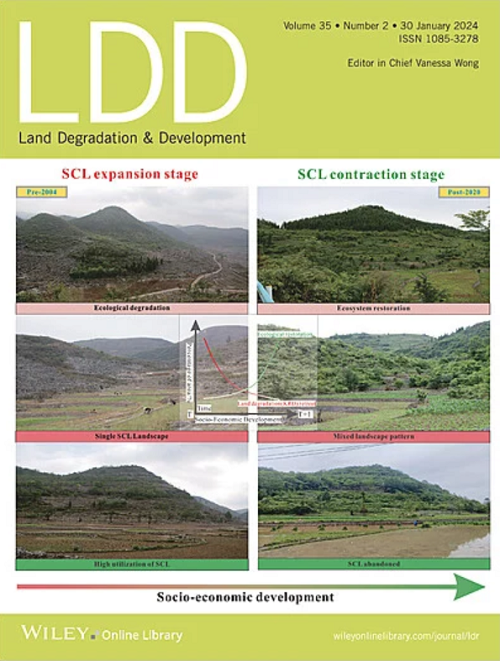Differential Response of Ecosystem Service to Restoration Methods and Restoration Time in Shallow Landslide-Prone Areas
IF 3.6
2区 农林科学
Q2 ENVIRONMENTAL SCIENCES
引用次数: 0
Abstract
Vegetation restoration effectively inhibits soil erosion, improves soil structure, increases soil carbon storage, and restores ecosystem service functions in vulnerable areas. Understanding the complex interactions between ecosystem services is essential for scientifically managing ecological restoration. However, systematic research in geohazard-prone areas with fragile ecosystems remains limited. Individual ecosystem services may exhibit varying trade-offs or synergies depending on restoration methods and duration, yet their relationships and optimization strategies are poorly understood. To address this, we investigated shallow landslide-prone areas in China where ecological restoration projects have been ongoing for 14 years. By assessing key ecosystem services-carbon storage, water conservation, and soil retention-under different restoration methods and duration, we found that ecosystem service capacity improved significantly, driven more by restoration modes than time. Artificial restoration had a greater positive impact than natural restoration. Over time, the soil and water conservation-carbon stock trade-off shifted toward continuous positive change. Additionally, the relationship between soil retention and water conservation transitioned from trade-off to synergy, indicating enhanced ecosystem functionality. Our study highlights the benefits of integrating restoration practices across management modes rather than time to develop sustainable ecosystem management strategies. These findings underscore the importance of artificial measures to strengthen ecosystem services in fragile and degraded areas.浅层滑坡易发区生态系统服务功能对恢复方式和恢复时间的差异响应
植被恢复能有效抑制土壤侵蚀,改善土壤结构,增加土壤碳储量,恢复脆弱区生态系统服务功能。了解生态系统服务之间复杂的相互作用对科学管理生态恢复至关重要。然而,在生态系统脆弱的地质灾害易发地区的系统研究仍然有限。根据恢复方法和持续时间的不同,个别生态系统服务可能表现出不同的权衡或协同作用,但它们之间的关系和优化策略却知之甚少。为了解决这个问题,我们调查了中国的浅层滑坡易发地区,这些地区的生态修复工程已经进行了14年。通过对不同修复方式和持续时间下的生态系统服务功能(碳储量、水分保持和土壤保持)的评估,我们发现,不同修复方式下的生态系统服务能力显著提高,修复方式对生态系统服务能力的影响大于时间。人工恢复比自然恢复有更大的积极影响。随着时间的推移,水土保持与碳储量的权衡关系转向持续的正变化。此外,水土保持与水土保持的关系由权衡关系向协同关系转变,表明生态系统功能增强。我们的研究强调了跨管理模式整合恢复实践的好处,而不是时间来制定可持续的生态系统管理战略。这些发现强调了在脆弱和退化地区采取人工措施加强生态系统服务的重要性。
本文章由计算机程序翻译,如有差异,请以英文原文为准。
求助全文
约1分钟内获得全文
求助全文
来源期刊

Land Degradation & Development
农林科学-环境科学
CiteScore
7.70
自引率
8.50%
发文量
379
审稿时长
5.5 months
期刊介绍:
Land Degradation & Development is an international journal which seeks to promote rational study of the recognition, monitoring, control and rehabilitation of degradation in terrestrial environments. The journal focuses on:
- what land degradation is;
- what causes land degradation;
- the impacts of land degradation
- the scale of land degradation;
- the history, current status or future trends of land degradation;
- avoidance, mitigation and control of land degradation;
- remedial actions to rehabilitate or restore degraded land;
- sustainable land management.
 求助内容:
求助内容: 应助结果提醒方式:
应助结果提醒方式:


